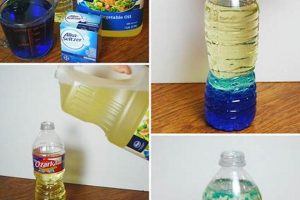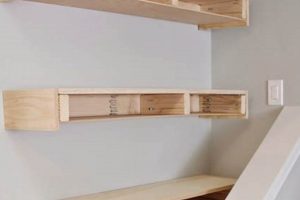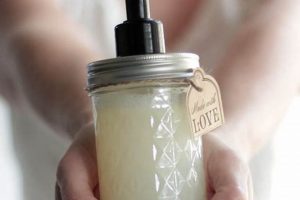Addressing minor damage to automotive glass independently involves specific techniques and materials. This process, often undertaken to prevent further cracking, utilizes resin injection systems to fill the void created by the impact. Successfully executed, the method restores structural integrity and improves visibility.
Timely intervention offers economic advantages by averting the need for complete windshield replacement. Furthermore, this practice aligns with resource conservation efforts, reducing waste associated with discarding damaged glass. Historically, the availability of commercial kits has democratized access to this form of vehicle maintenance, empowering vehicle owners to address minor imperfections promptly.
The following discussion will examine the tools required, detailed procedural steps, and potential risks associated with this approach, providing a balanced assessment for informed decision-making.
Tips for Addressing Automotive Glass Imperfections
The following points offer guidance when considering independent procedures for correcting minor windshield damage. Adherence to these suggestions can improve outcomes and minimize potential complications.
Tip 1: Assess Damage Extent. Prior to commencing any work, thoroughly evaluate the size and type of chip or crack. Damage exceeding a specific diameter or reaching the edge of the windshield may compromise structural integrity, potentially necessitating professional intervention.
Tip 2: Employ Proper Lighting. Adequate illumination is crucial for accurate placement of repair equipment and for observing the resin filling process. Direct sunlight or high-intensity lamps are recommended to ensure optimal visibility.
Tip 3: Maintain Surface Cleanliness. Contaminants, such as dirt and debris, can impede resin adhesion and compromise the repair’s effectiveness. Meticulously clean the damaged area using the provided cleaning solution and tools, following the kit’s instructions.
Tip 4: Ensure Correct Resin Application. The application of resin requires precise execution. Avoid air bubbles during injection, as these can weaken the repair. Utilize the pressure applicator according to the manufacturer’s specifications.
Tip 5: Allow Adequate Curing Time. Proper curing is essential for achieving optimal resin hardness and durability. Expose the repaired area to direct sunlight or utilize the provided curing strips for the recommended duration. Premature removal can lead to incomplete bonding.
Tip 6: Exercise Caution During Scraping. After curing, excess resin must be carefully removed from the windshield surface. Use the provided razor blade or scraper at a low angle to avoid scratching the surrounding glass.
Tip 7: Document the Process. Maintaining photographic records before, during, and after the repair provides valuable documentation of the procedure and its effectiveness. This documentation can be useful for future reference or potential insurance claims.
These guidelines offer a structured approach to mitigating minor automotive glass imperfections. Diligent application of these techniques enhances the likelihood of achieving satisfactory and lasting results.
The subsequent section will explore potential challenges and limitations inherent in this methodology, offering a comprehensive perspective.
1. Assessment
Comprehensive evaluation is paramount before initiating independent procedures aimed at rectifying minor windshield damage. This preliminary analysis determines the feasibility and appropriateness of addressing the damage independently, mitigating potential risks and ensuring satisfactory outcomes.
- Damage Type Classification
Windshield imperfections manifest in diverse forms, including bullseyes, stars, half-moons, and combination breaks. The type of damage significantly impacts the effectiveness of repair attempts. Bullseyes, characterized by a circular chip with a central impact point, are generally more amenable to filling. Star breaks, exhibiting radiating cracks, pose a greater challenge. Accurate classification of the damage type informs the selection of appropriate repair techniques and materials.
- Size and Depth Measurement
The dimensions of the damaged area, including its diameter and depth, are critical indicators of repair suitability. Damage exceeding a specific threshold, typically defined in commercial kits, is often beyond the scope of independent repair. Furthermore, deeply penetrated impacts may compromise the structural integrity of the glass, rendering them unsuitable for resin injection. Precise measurement is essential to determine whether the damage falls within the acceptable parameters for DIY repair.
- Location Analysis
The position of the damage on the windshield is a key consideration. Damage located within the driver’s primary field of vision can impair visibility and potentially compromise driving safety, even after repair. Furthermore, damage situated near the edge of the windshield is more susceptible to spreading due to stress concentration, necessitating professional intervention. An evaluation of the damage’s location is therefore crucial to ensure that the repair will not compromise safety or structural stability.
- Contamination Assessment
The presence of foreign matter, such as dirt, debris, or moisture, within the damaged area can impede resin adhesion and compromise the integrity of the repair. Contamination can also promote the formation of air pockets during resin injection, weakening the bond. Thorough inspection for contaminants and appropriate cleaning procedures are therefore essential steps in the assessment process.
These facets of assessment serve as critical determinants in the decision-making process. Rigorous adherence to these evaluation criteria allows for informed choices regarding the suitability of independent windshield repair, minimizing the likelihood of unsuccessful outcomes or potential hazards.
2. Kit Quality
The efficacy of independent windshield repair is fundamentally linked to the caliber of the repair kit employed. A substandard kit, characterized by inferior resin formulations, imprecise application tools, or inadequate curing mechanisms, will inevitably compromise the structural integrity and aesthetic outcome of the repair. Conversely, a well-engineered kit incorporating high-quality resin, precise injectors, and effective curing methods significantly increases the likelihood of a successful and durable repair. The direct correlation between kit quality and repair effectiveness underscores the importance of judicious selection.
Resin composition is a critical determinant of kit quality. High-grade resins exhibit optimal clarity, refractive index, and bonding strength, effectively minimizing visibili
ty of the repaired area and ensuring a robust structural bond with the surrounding glass. Inferior resins may exhibit discoloration, incomplete bonding, or premature degradation under environmental stressors. Furthermore, the precision of injection tools is essential for accurate resin placement and air bubble prevention. Defective injectors can introduce air pockets, weakening the repair and detracting from visual clarity. Similarly, the effectiveness of the curing mechanism, whether it involves UV light or adhesive strips, directly impacts the resin’s hardening and bonding properties. Inadequate curing can lead to a soft, pliable repair that is susceptible to cracking or discoloration over time.
In conclusion, selecting a reputable repair kit with verified resin quality, precise application tools, and a reliable curing process is essential for achieving a satisfactory result. Compromising on kit quality can nullify the benefits of independent repair, potentially leading to further damage or the need for professional intervention. Prudent investment in a high-quality kit, coupled with meticulous adherence to instructions, enhances the likelihood of a structurally sound and visually unobtrusive repair.
3. Procedure Adherence
Successful execution of independent automotive glass restoration hinges on rigorous adherence to the established methodology. Deviation from prescribed steps during resin injection or curing phases introduces variability, directly affecting the repair’s longevity and structural integrity. For example, failing to adequately clean the damaged area prior to resin application inhibits proper bonding, potentially leading to future crack propagation. Skipping the vacuuming step designed to remove air and debris can trap contaminants within the repair, causing visual imperfections and compromising the strength of the resin bond. A further instance involves premature removal of curing strips or insufficient UV exposure, which hinders complete resin polymerization, yielding a weak and unstable repair susceptible to further damage.
The precise sequence of steps in automotive glass restoration kits reflects optimized material interactions and surface preparations. Each step serves a distinct purpose, contributing to the overall cohesive nature of the repair. Proper cleaning removes loose fragments and contaminants, creating a receptive surface for the resin. The application bridge or applicator device ensures accurate alignment and controlled resin delivery to the impacted zone. Resin injection fills the void, restoring structural continuity to the damaged glass. Curing hardens the resin, creating a permanent bond. Any deviation from this sequence jeopardizes the efficacy of the repair, potentially leading to aesthetic blemishes, weakened structural properties, or eventual failure of the repair.
Therefore, rigorous adherence to the prescribed procedure is not merely a suggestion but a prerequisite for effective independent automotive glass restoration. Understanding the rationale behind each step, meticulous execution, and careful attention to detail significantly improve the likelihood of a successful and durable repair. The economic and environmental benefits of windshield repair are only fully realized when the prescribed steps are followed meticulously.
4. Environmental Conditions
Environmental factors exert a considerable influence on the success of independent automotive glass restoration. Temperature, humidity, and direct sunlight exposure can significantly impact resin viscosity, curing rates, and ultimately, the bond strength achieved during the repair process. Understanding and controlling these variables is crucial for optimizing repair outcomes.
- Temperature Impact on Resin Viscosity
Resin viscosity, the measure of a fluid’s resistance to flow, is highly sensitive to temperature variations. Lower temperatures increase resin viscosity, impeding its ability to penetrate narrow cracks and voids within the damaged area. Conversely, excessively high temperatures decrease viscosity, potentially causing the resin to flow uncontrollably and creating air pockets. The ideal temperature range, typically specified in repair kit instructions, ensures optimal resin flow and maximizes the likelihood of complete filling. For example, a repair attempted on a cold winter day without pre-warming the windshield and resin may result in incomplete penetration and a weakened bond.
- Humidity Influence on Resin Curing
High humidity levels can interfere with the resin curing process, particularly with UV-curing resins. Moisture on the windshield surface or within the damaged area can inhibit resin polymerization, resulting in a soft, tacky finish that is susceptible to cracking and discoloration. Furthermore, humidity can affect the bonding strength of adhesive curing strips, compromising their ability to maintain pressure during the curing process. A repair performed on a rainy day or in a humid environment may exhibit delayed curing and reduced durability.
- Sunlight Exposure and Curing Rate
Direct sunlight provides the UV radiation necessary for curing certain types of resins used in windshield repair kits. However, uncontrolled exposure to direct sunlight can accelerate the curing process excessively, leading to uneven hardening and potentially compromising the structural integrity of the repair. Conversely, insufficient sunlight exposure can prolong the curing time, increasing the risk of contamination or disturbance during the curing phase. The optimal approach involves controlled exposure to indirect sunlight or the use of a dedicated UV curing lamp, ensuring a consistent and complete curing process.
- Wind and Particulate Matter Contamination
Outdoor wind conditions can introduce airborne particulate matter, such as dust, pollen, and insects, to the repair site. These contaminants can adhere to the resin surface during application or curing, compromising the clarity and bond strength of the repair. Furthermore, wind can disrupt the alignment of repair tools and curing strips, potentially leading to misalignment or incomplete resin filling. Performing the repair in a sheltered environment, such as a garage or carport, minimizes the risk of particulate matter contamination and ensures a cleaner, more effective repair.
Therefore, meticulous attention to environmental conditions is paramount for achieving optimal outcomes. Adjusting the repair environment to mitigate temperature extremes, humidity fluctuations, and wind exposure can significantly enhance the likelihood of a durable and visually unobtrusive repair. Failure to account for these variables may result in a compromised repair that necessitates professional intervention.
5. Curing Process
The curing process represents a critical stage in the restoration of automotive glass through independent methods. It directly influences the final hardness, clarity, and longevity of the repair, effectively transforming the liquid resin into a solid, durable material that bonds with the existing glass structure.
- UV Light Exposure
Many resins employed in independent automotive g
lass repair kits require exposure to ultraviolet (UV) light for polymerization. This process converts the liquid resin into a hardened state, creating a durable bond with the surrounding glass. Insufficient UV exposure results in a soft, pliable resin that is susceptible to cracking or discoloration. Conversely, excessive exposure can lead to premature hardening and reduced bonding strength. The duration and intensity of UV exposure must adhere strictly to the manufacturer’s guidelines to achieve optimal curing. - Curing Strips and Pressure Application
Certain repair kits utilize adhesive curing strips designed to apply consistent pressure to the resin-filled area during the curing phase. This pressure helps to eliminate air pockets and ensure intimate contact between the resin and the glass surface. Inadequate pressure can lead to incomplete bonding and visual imperfections. The curing strips must be applied carefully and maintained throughout the recommended curing period to ensure optimal resin adhesion.
- Ambient Temperature Considerations
Ambient temperature exerts a considerable influence on the resin curing rate. Lower temperatures can slow down the curing process, requiring extended exposure to UV light or longer application of curing strips. Elevated temperatures can accelerate the curing process, potentially leading to premature hardening and reduced bonding strength. The repair should be performed within the temperature range specified by the repair kit manufacturer to ensure optimal curing and bond integrity.
- Post-Curing Inspection and Finishing
Following the designated curing period, a thorough inspection of the repaired area is essential. This inspection assesses the resin’s hardness, clarity, and bonding with the surrounding glass. Any imperfections, such as air pockets or incomplete filling, should be addressed promptly. Excess resin is typically removed with a razor blade, taking care not to scratch the surrounding glass surface. Polishing the repaired area enhances visual clarity and blends the repair seamlessly with the existing windshield.
Proper execution of the curing process is paramount for achieving a successful and durable repair. Failure to adhere to the manufacturer’s instructions regarding UV exposure, pressure application, temperature control, and post-curing inspection can compromise the integrity of the repair, potentially leading to further damage or the need for professional intervention. A meticulously executed curing process significantly enhances the longevity and aesthetic outcome of independent automotive glass restoration.
6. Longevity Expectation
Understanding the projected lifespan of independent automotive glass repairs is crucial for informed decision-making. While addressing minor windshield damage independently offers immediate benefits, acknowledging the inherent limitations regarding long-term durability is paramount.
- Resin Degradation
The resin employed in repair kits is susceptible to degradation from prolonged exposure to ultraviolet radiation, temperature fluctuations, and environmental contaminants. Over time, this degradation can manifest as discoloration, reduced bonding strength, and increased susceptibility to cracking. While protective coatings can mitigate these effects, they do not eliminate the eventual degradation of the resin. A repair performed five years prior may exhibit significantly diminished structural integrity compared to a newly executed repair.
- Stress Cracking Propagation
The repaired area remains a point of stress concentration on the windshield. While the resin effectively fills the void created by the initial damage, it does not entirely eliminate the risk of stress cracking propagating from the repair site. Vibrations, temperature fluctuations, and impacts can exert stress on the repaired area, potentially leading to the formation of new cracks or the expansion of existing cracks. A previously repaired chip may, under certain conditions, develop radiating cracks that necessitate windshield replacement.
- Environmental Factors and Wear
Exposure to harsh weather conditions, such as extreme temperatures, hail, and ice, can accelerate the wear and tear on repaired areas. Repeated cycles of freezing and thawing can weaken the resin bond, increasing the risk of cracking or delamination. Furthermore, the impact of road debris, such as stones and gravel, can cause further damage to the repaired area, potentially leading to its eventual failure. Windshield repairs in regions with severe weather conditions may exhibit a shorter lifespan compared to repairs in milder climates.
- Repair Quality and Skill Level
The ultimate longevity of a repair depends heavily on the quality of the materials used, the skill of the individual performing the repair, and the adherence to proper procedures. Substandard repair kits, inadequate surface preparation, or improper resin application can significantly reduce the lifespan of the repair. A poorly executed repair may fail prematurely, requiring professional intervention or windshield replacement. Even with high-quality materials and meticulous technique, the repaired area remains a vulnerable point on the windshield.
The realistic expectation for independent automotive glass repairs is that they provide a temporary or short-term solution. While they can effectively address minor damage and prevent further cracking, they are not intended to serve as permanent fixes. Regular inspections of repaired areas are recommended to monitor for signs of degradation or stress cracking. When faced with significant damage or uncertainty regarding the repair’s integrity, seeking professional evaluation and repair is prudent.
DIY Windshield Chip Repair
The following questions address common inquiries regarding independent procedures for rectifying minor windshield damage. The information provided aims to offer clarity and inform decision-making regarding this practice.
Question 1: Can this method restore a windshield to its original factory condition?
No, the process aims to mitigate further cracking and improve visibility. While a successful procedure can significantly reduce the appearance of damage, it will not restore the windshield to its original, flawless state. Minor visual imperfections may remain.
Question 2: What types of damage are suitable for independent repair attempts?
This is generally appropriate for small chips and cracks, typically those less than one inch in diameter. Star-shaped breaks or cracks extending to the edge of the windshield are often beyond the scope of independent repair and may require professional attention.
Question 3: Is specialized experience required to perform this procedure effectively?
While no formal training is required, patience and meticulous attention to detail are essential. Adherence to the instructions provided with the repair kit is crucial for a successful outcome. Practicing on a piece of scrap glass beforehand can improve proficiency.
Question 4: What is the expected lifespan of a typical independent repair?
The longevity of a repair varies depending on factors such as environmental conditions, the quality of materials used, and the severity of the initial damage. While some repairs may last for several years, others may require periodic reapplication or eventual professional intervention.
Questi
on 5: Does this void a vehicle’s warranty?
Modifying a vehicle component, including the windshield, may potentially affect certain warranty provisions. Consult the vehicle’s warranty documentation or contact the manufacturer to determine the specific impact of this procedure on warranty coverage.
Question 6: What are the potential risks associated with attempting this repair?
Improper technique or the use of substandard materials can exacerbate existing damage or compromise the structural integrity of the windshield. Furthermore, attempting to repair damage beyond one’s skill level can result in further cracking and necessitate complete windshield replacement.
In summary, independent windshield repair offers a cost-effective solution for addressing minor damage. However, a clear understanding of its limitations and potential risks is crucial for making informed decisions and achieving satisfactory results.
The subsequent segment will address safety precautions related to this practice, emphasizing the importance of protective measures and responsible execution.
DIY Windshield Chip Repair
This examination of diy windshield chip repair has illuminated both its potential benefits and inherent limitations. Successful implementation hinges upon accurate damage assessment, utilization of high-quality repair kits, meticulous adherence to procedural guidelines, and careful consideration of environmental factors. The curing process represents a critical phase, directly influencing the repair’s long-term durability. Realistic expectations regarding longevity are essential, recognizing that independent repairs may not fully restore a windshield to its original structural integrity or aesthetic condition.
Ultimately, the decision to undertake diy windshield chip repair requires a balanced evaluation of these factors. Vehicle owners are encouraged to prioritize safety and exercise prudence when considering this approach. If uncertainties exist regarding the severity of damage or the suitability of independent repair, seeking professional evaluation remains the most responsible course of action, ensuring both structural integrity and driver safety are paramount.







